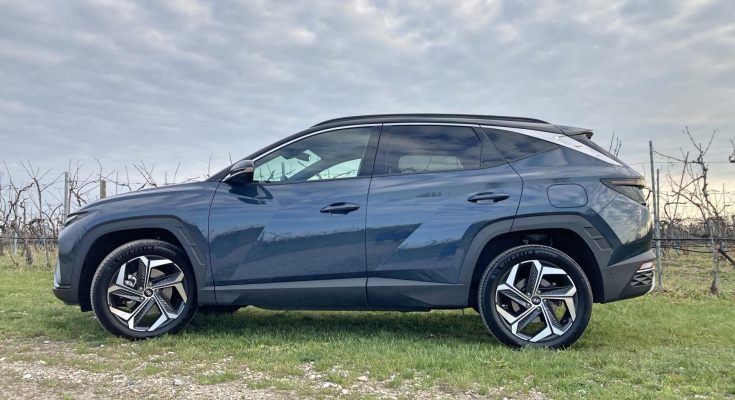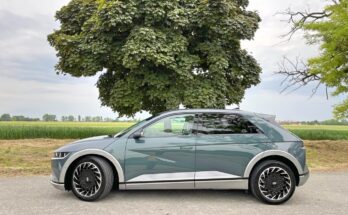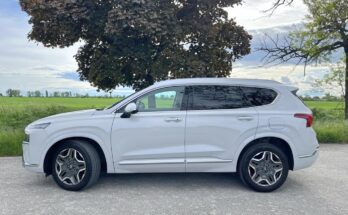In the past year, Hyundai modernized the entire range of its passenger cars and, for the main models, also offered a choice of classic combustion, hybrid and plug-in hybrid units. So it can be said that practically everyone will find something for themselves.
Imagination is the engine of innovation, and the South Korean automaker Hyundai has taken this motto as its own. It steps up its efforts to invent new things from year to year, and this is fully reflected in the cars of this brand. Take the new Tucson for example: a more original and modern car Hyundai could not even offer…

We've learned pretty much everything about the new Hyundai Tucson over the past few months, except how it drives. I found this out for the first time last week and it was clear to me from the first moment that I would not be able to hide from the prying eyes of passers-by with this car. And so it was. It's been a long time since I've had people talk to me in parking lots – what is this new thing and how much does it cost and is it some kind of space technology??

The rounded shape is probably over and the angular style is coming. The anthracite radiator grille shocks not only with its dimensions, but mainly with its LED headlights resembling angel wings. You won't mistake the Tucson for any other car. This is due not only to the front part with the radiator mask with hidden headlights, but also to the specifically shaped rear part, where the headlights play the main role again. They have two "teeth" on the sides and are connected by a light strip across the entire width. The interesting thing is that the direction indicators are in the bumper and are made of ordinary light bulbs, while the headlights are LEDs.

At the back, the emblem of the car company on the rear glass is also interesting, which looks as if the engineers decided at the last moment not to put the planned wiper there. But he is here, just not visible at first glance, because he is hidden behind the roof spoiler. However, it wipes a small part of the window and that too in an unnatural position, so I give an imaginary point down for this "trick". Regarding the design, one could describe the clouds of speechless text… maybe photos and video will be a better helper: Hyundai Tucson Hybrid – Intr o

The interior of the new Tucson, and especially the architecture of the dashboard, is modern and, in today's flood of design pasquills, extremely refreshing. The ten and a quarter inch large digital instrument panel does not have such a typical chapel and is as if embedded in the dashboard. You will be pleased with the perfectly fast graphics and one more trick: instead of one of the alarms, when indicating a change of direction, you will be shown the camera monitoring of the blind spot, similar to, for example, the new generation Kia Sorento. The equally large screen of the central infotainment is beautifully fitted, also at the level of the dashboard. It does not stand out, it does not interfere, it fits into the design like a glove.

However, I do not find the infotainment environment as intuitive as before, but in many ways it will become a habit. But I would especially welcome hardware buttons for turning off some assistants and some dominant button for the Home function, which can be hidden very well in some applications. The very wide center console provides perhaps too many buttons, all of which are also tactile and unrecognizable by touch. It's also a shame about the black piano lacquer on the plastic paneling, it somewhat detracts from the beautiful design style inside, and of course fingerprints and dust are immediately visible. On the other hand, the control buttons for controlling the vehicle's functions, including those for manipulating the gearbox, are nicely laid out. I don't miss a lever at all, and there won't be any in the future either… bye bye!

Up front, the Tucson sits high (but not unnaturally) and this naturally improves the view from the vehicle. The wide console with the tunnel is a bit in the way of the driver's right knee (sometimes more than a bit…), but otherwise the ergonomics of the seat are at a very good level. The seats are such a better average, they lack a more prominent side guide. I praise the well-designed air conditioning vents around the perimeter of the dashboard and also the hand-fitting ring of the steering wheel, which I can finally hold in the most comfortable position, thanks to the two transverse grips in the lower part.

The Tucson has grown between generations in all directions, and even if these are insignificant numbers at first glance, primarily thanks to the extension of the wheelbase and the body, it was possible to conjure up 26 millimeters more knee room in the rear seats. This is naturally desirable and welcome in a family SUV.

It also fits well on the back bench, and it won't be a problem when handling child seats. Under the seats (and a little behind them…) there is a hidden Li-Pol battery with a capacity of 1.5 kWh, so even with a hybrid, you can put up to 616 liters of luggage in the trunk, which is more than, for example, a Skoda Karoq.

The tested Hyundai Tucson is a full-hybrid, which has a 1.6-liter gasoline engine labeled SmartStream with direct fuel injection and a decent 180 horsepower (and a maximum torque of 265 Nm). This engine is supported by an electric motor with a power of 60 hp. Systemically, the hybrid Tucson can develop up to 230 horsepower, while the system is coupled with a six-speed TRANSMISSION! automatic (other versions with an automatic have a double-clutch DCT transmission). That definitely doesn't sound bad, the sprint from rest to 100 km/h in exactly 8 seconds (for the 4×4 version you have to count with 8.3 seconds) then it's not to be thrown away either.

The hybrid runs amazingly smoothly, although the transmission is still a bit slow and likes to under-rev the engine. Fortunately, it does not rev the engine like a CVT, so it is not unpleasant for a person and the untrained ear may not even notice it. The engine itself is perfectly soundproofed. Basically, you will always go to ECO mode, while there is also Sport (and into the terrain of fashion suitable for mud, snow and sand), which kicks up the response from the pedals, and with the Tucson it starts to sweep properly…
Hyundai Tucson's assistance systems rank somewhere at the top of what you can get in today's cars. There is monitoring of the entire area around the vehicle, it will tell you if you can get out safely, or if you have forgotten something in the back seats. It almost perfectly eliminates all blind spots, and when changing lanes, you will greatly appreciate the already mentioned display of the situation behind the vehicle in one of the circular indicators on the dashboard. All those cameras just need to be properly cleaned, because after the first ride through the mud, all of this will suddenly disappear…

In the first corner, however, you realize that we are dealing with 1,800 kilograms of weight, so the car leans very willingly and starts to understeer quite quickly. Fortunately, stability does not suffer from this, but it is clear that this car was designed mainly for comfortable and gentle driving. The chassis also thrives on bumps, although I would rather accept a smaller wheel size here than the 19″ ones, with which the deeper recess here and there throws the rear axle a bit. However, shock absorption from the chassis is exemplary.

The 6-speed automatic works almost completely without reservations. Sometimes it holds the revs unnecessarily when starting, but otherwise it shifts smoothly and quickly. In ECO mode, it can even let the engine cruise in neutral – as long as the battery is charged to at least half of its capacity, thus contributing to fuel savings. In Sport mode, during sportier driving, it is able to keep the engine revving for longer when changing gears, thus contributing to a livelier performance and better acceleration.
However, I can forget about the paper 5.5 liters in combined mode with my driving style. I averaged around the long term average of over 7 liters. Of course, I drove like a regular car.

Here it turns out that hybrid cars are not such a nightmare. Their advantages can also be applied in practice if someone is able to drive in a mode in which the vehicle is efficient – i.e. brake regularly so that only the electric motor recuperating kinetic energy comes into play. Then you can use otherwise wasted energy again for the drive and increase the efficiency of the entire drive. But only a few percent of people, if at all, will drive like this. Most either drive so slowly that they basically don't brake, and here the hybrid component of the drive is practically useless, and with an internal combustion engine they drive a car weighing 1,830 kilograms with batteries that didn't even have to be there…

You will especially appreciate the help of electricity in the city, where the consumption is also more moderate. However, Hyundai will also offer the Tucson as a plug-in hybrid, and there the more significant involvement of driving on electricity could reduce the appetite of the device with the gasoline unit at the head a little. We'll see at what price…
The tested Hyundai Tucson surprises with the driving comfort, because the adaptive chassis works very well, but also with relatively decent silence on board. This applies to quiet driving in the city and outside it. On the highway, however, due to the low torque, the car often downshifts uphill, which is accompanied by slight jerks, but in the end also a significantly louder engine sound.

All in all, it is a good car to drive and feel, which many competitors should pay close attention to. The fourth generation Tucson with hybrid technology starts at €29,090 according to the current price list and actually contains everything essential that an ordinary driver might need. For some €6,000 in addition, you have the fully equipped Premium version, where luckily only the additional adaptive cruise control will be missing.
| New Hyundai Tucson: Technical data of gasoline and hybrid engines | ||||
|---|---|---|---|---|
| Engine | 1.6 T-GDI | 1.6 T-GDI MHEV | 1.6 T-GDI MHEV | 1.6 T-GDI HEV |
| Drive | 4×2 (4×4) | 4×2 | 4×2 (4×4) | 4×2 (4×4) |
| Cylinders/valves | 4/4 | 4/4 | 4/4 | 4/4 |
| Displacement volume [cm 3 ] | 1598 | 1598 | 1598 | 1598 |
| Power [kW] | 110 | 110 | 132 | 169* |
| Torque [Nm/min] | 250/1500 | 250/1500 | 265/1500 | 264/1500 |
| Gearbox | 6M | 6M (7A) | 6M (7A) | 6A |
| Max. speed [km/h] | 189 | 189 | 205 (201) | 193 |
| Acceleration 0-100 km/h [s] | 10.3 | 10.3 | 9.4 | 8.0 |
| Consumption WLTP [l/100 km] | 6.6 | 6.5 (6.3) | 6.4 (6.7) | 5.5 |
| *total performance of the hybrid system |
You can find the entire photo gallery here:
































